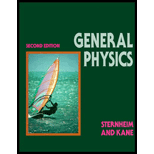
(a)
Energy emitted due to transition.
(a)
Answer to Problem 44E
The photon of energy emitted is
Explanation of Solution
Write the expression for energy of diatomic molecule.
Here,
Write the expression for change in energy due to transition.
Conclusion:
Substitute
Substitute
Substitute
Thus, the energy of photon emitted is
(b)
The wavelength of photon emitted.
(b)
Answer to Problem 44E
The wavelength of photon emitted is
Explanation of Solution
Write the expression for energy of photon emitted.
Here,
Rearrange the above expression for
Conclusion:
Substitute
Thus, the wavelength of photon emitted is
Want to see more full solutions like this?
Chapter 27 Solutions
General Physics, 2nd Edition
- how do you do part b of this frq? this is a non graded practice worksheetarrow_forwardThe energy levels of the Bohr model for the atom can be expressed mathematically as En -13.6 eV, where Z is the atomic number, and n is the quantum number. This model is reasonably accurate for hydrogen and for singly ionized helium. The photon associated with the transition of an electron from the ground state to the first excited state in singly ionized helium has a different wavelength than that associated with a similar transition in hydrogen. Which of the following correctly describes the wavelengths of these two photons in terms of the energy level diagrams for hydrogen and helium? The photon absorbed by hydrogen has a longer wavelength than that absorbed by helium, because the energy levels in the diagram for hydrogen are more closely spaced than in the diagram for helium. B The photon absorbed by hydrogen has a shorter wavelength than that absorbed by helium, because the energy levels in the diagram for hydrogen are more closely spaced than in the diagram for helium. The photon…arrow_forwardCalculate the wavelength associated with an electron with energy of 1.0 eV if the electron is inside a GaAs crystal. (The mass of an electron in GaAs is 0.067 X 9.11 X 10-31 Kg)arrow_forward
- In X-ray fluorescence (XRF), the energy of the characteristic Ka line of iron (Fe) is 6.405 keV. Calculate the wavelength (in Å) corresponding to this line and state what electronic transition this represents. (DATA: h = 6.626 x 10-34 J s; c = 2.998 x 108 m s-1; e = 1.602 x 10-19 C)arrow_forwardThe intensity of a laser in free space is150mW / m? . The corresponding amplitude of the V (6, = 8.854x10-12 C² /N.m² ) electric field of the laser isarrow_forwardA sodium atom of mass 3.82 * 10^-26 kg vibrates with simple harmonic motion in crystal. The potential energy increases by 0.0075 eV when the atom is displaced 0.014 nm from its equilibrium position. Find the wavelength of a photon emitted when n=6 to n=1 transition occurs.arrow_forward
- A laser emits 5.50 x 1018 photons per second, using a transition from an excited state with energy 1.15 eV to a ground state with energy 0 eV. (a) What is the laser’s power output? (b) What is the wavelength?arrow_forwardThe wavelength of light from a lead-selenide (solid-state) laser is 32 um, and the power output is 2.6 mW. How many transitions occur each second? (um 10m, mW 10W) A: 5.690x1016 B: 7.568x1016 oC: 1.007x1017 D: 1.339x1017| E: 1.781x1017 OF: 2.368x1017 G: 3.150x1017 H: 4.189x1017arrow_forwardQuestion 9. While most transition metals have work functions corresponding to photon frequencies that are larger (higher) than visible light, alkali and alkaline earth metals have low-energy work functions. For example, calcium has a work function of o = 4.3419×10-19 J. (a) What is the initial state n, for the hydrogen emission lines at visible wavelengths (i.e., those with n = 2) for the lowest-energy photon that would eject an electron from calcium? %3! (b) If the colors of the visible hydrogen emission lines (n; = 3 to n = 6) are red, green, blue and %3D violet, which colors are capable of ejecting the electrons from calcium? (c) The energy of the emitted photon you identified in part (a), is not identical to the workfunction of calcium. Therefore, the electron is ejected from the metal surface with some kinetic energy (i.e., energy is conserved in the photoelectric effect process). What would the velocity of the electron ejected from calcium (in meters per second)?arrow_forward
- How many photons are emitted per second from a semiconductor laser which emits 0.75 mW of light at a wavelength of 540 nm? O 239E+15 O 2.04E+15 O 2.85E+15 O 3.21E+15arrow_forwardA collection of atoms has 20% of the sample in a state 4.7 eV above the ground state. If these emit coherent radiation, what is the wavelength of the laser light produced in nanometers? Please give your answer with no decimal places. (c = 3.00 × 108 m/s, h = 6.626 × 10-34 J ∙ s, 1 eV = 1.60 × 10-19 J)arrow_forwardRecall from Section 14.3 that the average kinetic energy of an atom in a monatomic ideal gas is given by KE=(3/2)kT, where k = 1.38 x 10-23 J/K and T is the Kelvin temperature of the gas. Determine the de Broglie wavelength of a helium atom (mass = 6.65 x 10-27 kg) that has the average kinetic energy at room temperature (292 K). Number i 7.38E-11 Units marrow_forward
 University Physics Volume 3PhysicsISBN:9781938168185Author:William Moebs, Jeff SannyPublisher:OpenStax
University Physics Volume 3PhysicsISBN:9781938168185Author:William Moebs, Jeff SannyPublisher:OpenStax
 Principles of Physics: A Calculus-Based TextPhysicsISBN:9781133104261Author:Raymond A. Serway, John W. JewettPublisher:Cengage Learning
Principles of Physics: A Calculus-Based TextPhysicsISBN:9781133104261Author:Raymond A. Serway, John W. JewettPublisher:Cengage Learning


